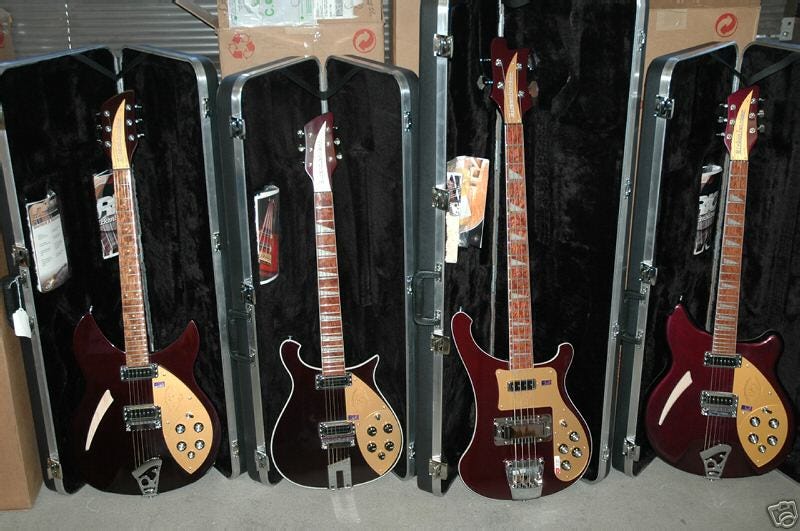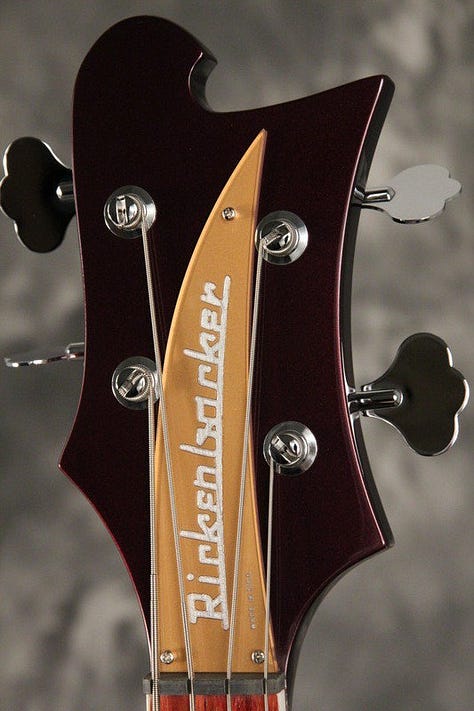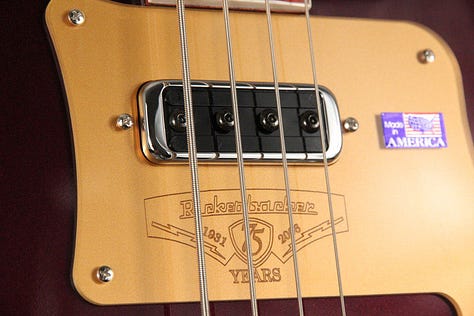In July of 2006 John Hall teased the release of “something special” for the company’s upcoming 75th anniversary. Something “4x75” special, in his words. The boards caught fire speculating, egged on by the Halls and factory insiders. On September 1st speculation ended with the following press release (thank god for the Wayback Machine!):
“Rickenbacker International Corporation is pleased to announce four limited edition guitars to commemorate the 75th anniversary of both our company and the electric guitar itself.
These instruments will feature a special finish (Dark Cherry Metallic), a gold pickguard with a unique 75th anniversary logo, and a matching gold nameplate.
Featured in this limited run of 75 guitars per model will be the Model 330, 360, 660 and 4003.
U.S. suggested retail prices will be as follows:
Model 330: $2019
Model 360: $2159
Model 660: $2509
Model 4003: $2139
Orders for these instruments were taken beginning at 8:00 AM Pacific Time on September 1, 2006 and SOLD OUT by noon.
60 units of each type were available for sale in North America, the remainder were allocated for export.
No 12 string or left-handed orders were taken in this series in order to expedite delivery.”

So four standard models in a special color with a special pickguard and truss rod cover. Pretty cool! They came with standard plastic hard shell cases and no certificate of authenticity.



And lemme tell you, they look great. The color is great, the laser engraved gold pickguards look great, and the “unique to this run” gold plexi truss rod cover with silver lettering look great. But when they got out into the world…there was something wrong with the finish. And it got worse with time.
The symptoms vary in type and severity, but they come down to three basic issues: excessive (for Rickenbacker) finish checking, a “gummy” or “sticky” finish, and—in extreme cases—finish flaking.
We’ll probably never know exactly what the issue was—although my money is more on the finish itself than anything in the process. Or rather, how that particular color interacted with the curing process. I mean, if we found the same issues on every color made during the same time period that would be a different story. But we don’t. It’s only the Dark Cherry Metallic.
And it’s really two basic problems. The finish is either too brittle and it cracks and (potentially) loses adhesion, which points towards overcuring, or too soft so it gets sticky, which points towards undercuring. Which is weird, to see both things, right?
But they weren’t ALL bad. A significant percentage are just fine! And you can find sequential serial numbers that are good then bad. That’s what makes it a real head scratcher. And that’s what makes buying one today a challenge. How do you KNOW if it’s a good one or not without laying hands on it?
Personally, I wouldn’t. But there are some things you can tell from photos to help rule a guitar OUT of consideration.
So checking and flaking are related to each other, and that’s easy to spot. Now just because a guitar has checking doesn’t mean it’s gonna flake, but the more checking you see, the more “brittle” the finish is and the more potential you have for flaking. So a few finish checks are not cause for immediate rejection—although they do reduce the value—but if you see a whole bunch…probably best to keep looking for another one.
Sticky/gummy is a little bit harder to spot, but not impossible. What you’re looking for here is a lack of shine/reflection. It’s easiest to spot on the back, where you’ve got a large flat surface that’s probably spent most of its life pressed against a fuzzy/furry case lining. If it looks dirty, or smudged, or flat…you want a reflective surface. You don’t see that, run.

Still, I’d want to touch it myself first. Which is why I don’t recommend buying these guys sight unseen. But if you can look at it and touch it..what a beaut these guys are when they’re good!



